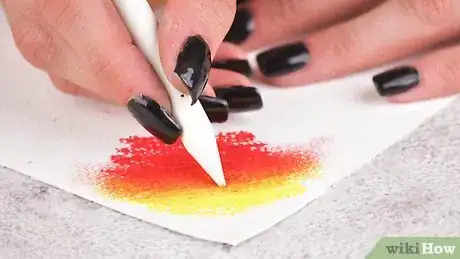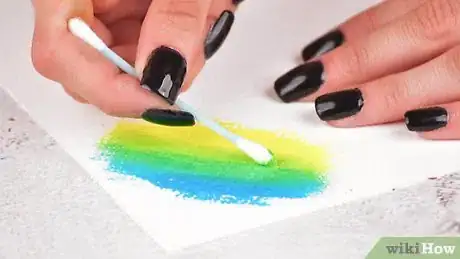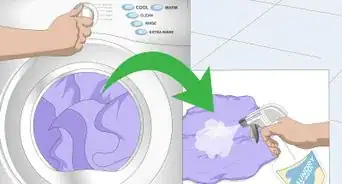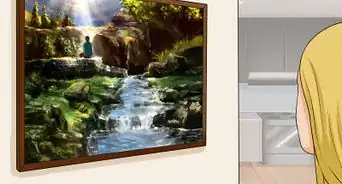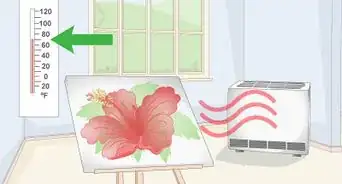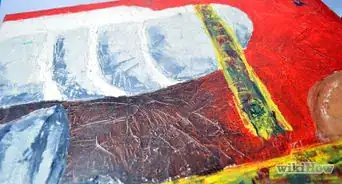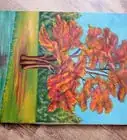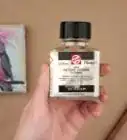This article was co-authored by Kelly Medford. Kelly Medford is an American painter based in Rome, Italy. She studied classical painting, drawing and printmaking both in the U.S. and in Italy. She works primarily en plein air on the streets of Rome, and also travels for private international collectors on commission. She founded Sketching Rome Tours in 2012 where she teaches sketchbook journaling to visitors of Rome. Kelly is a graduate of the Florence Academy of Art.
wikiHow marks an article as reader-approved once it receives enough positive feedback. In this case, 81% of readers who voted found the article helpful, earning it our reader-approved status.
This article has been viewed 225,059 times.
Oil pastels are thick, greasy sticks of pigment blended with a mineral oil binder. Their composition makes them extremely versatile and recognizable. Artists may apply, manipulate, and blend oil pastels in a multitude of ways to achieve different effects, hues, and textures.
Steps
Pre-Blending, Blending, and Color Mixing Your Oil Pastels
-
1Pre-blend your oil pastels. When you pre-blend your oil pastels, you blend the colors together on a palette prior to applying the materials to your canvas. This method yields one color. You may wish to use it when you are trying to create a specific color and or do not wish to risk mixing the wrong colors together on your canvas.
- Use a palette knife to cut off pieces of the oil pastels you wish to blend. Place the pieces on your palette.
- Use the palette knife to blend or mix the colors together until they form a thick, oily paint.
- Once you achieve the desired hue, apply the pigment to your canvas with the palette knife.
- Instead of a palette knife, you may use your fingers.[1]
-
2Blend your oil pastels. Apply one color of oil pastel directly onto your canvas. Apply a second color of oil pastel directly next to the first color. Use your tool of choice to blend, or rub, the adjoining edges together until the two edges appear smooth.
- This method is used when you want to achieve a smooth organic gradient.[2]
- It is possible to blend oil pastels in this manner because the material is thick and oily.
Advertisement -
3Color mix or overlay your oil pastels. Color mixing is a process of layering oil pastels directly on the canvas. This method is used to blend larger areas of color as opposed to smaller areas requiring fine detail work, which would be better achieved with blending. It creates extremely rich tones. Apply one generous layer of oil pastel to your canvas, followed by a second layer of a different color. Add additional layers and blend the pastels together until you achieve the desired hue.
- Experiment with light pressure blending. Instead of layering thick applications of oil pastels, use minimal pressure to apply thin coats of oil pastels to your canvas.[3]
Exploring Alternative Blending Methods
-
1Blend your oil pastels with the scumbling method. The scumbling method allows artists to develop texture and value in their works. To execute this blending method, select two or more colors of oil pastels. Choose one color and begin creating controlled scribble marks across your canvas. Repeat this process with the remaining colors you selected, overlapping the colors at various, random points. Continue to layer the scribbled colors until you achieve the desired look and hue.[4]
-
2Use the cross-hatch method to blend oil pastels. When executing the cross-hatching method, artists blend colors together by drawing overlapping lines in two distinct directions.
- Lightly sketch the area you wish to cross hatch.
- Select two colors of oil pastels, preferably a light and a dark shade.
- Determine the two directions of your lines. Assign a color to each direction.
- Draw a series of lines with one color going in one direction.
- Draw a second series of lines with the second color going in a different direction.
- Continue to fill in the area with lines until you achieve the desired effect.
-
3Apply the sgraffito method. In the sgraffito method, artists create a design or add fine details by scratching through layers of oil pastels.
- Apply multiple layers of oil pastels in various contrasting colors to your canvas. Often, the last layer is a dark color.[5]
- Select a pointed object of your choice, such as: a paper clip, a comb, or a wooden stylus.
- Use this sharp item to scratch away the layers of oil pastels, leaving behind an intricate design.[6]
Experimenting with Different Tools
-
1Blend with your fingers. Your fingers are excellent and efficient blending tools. While your fingers are not as precise as other tools, they are ideal for blending colors together that cover large areas of your work. It is also quicker to blend with your fingers than it is to grab a tool. When using your fingers, remember to wash your hands frequently to remove the pigment and prevent blending the wrong colors together.
- You may wish to wear rubber gloves or finger clots. These will make it easier for you to keep your hands clean and will protect your fingers from being rubbed raw by the sand on the canvas or in the pastels.
- Keep wet wipes near your workstation to remove the pastels from your hands.
- It may be difficult to blend areas that are smaller than your fingertips.[7]
-
2Use pastel brushes or shapers to blend the colors. Pastel brushes and shapers are specifically designed for working with oil pastels. Pastel brushes, which come in a variety of sizes and styles, contain hairs on one end. Pastel shapers, which also come in a variety of sizes and styles, have a flat or tapered rubber end. While flat pastel shapers are ideal for blending large areas of colors together, tapered pastel shapers are perfect for blending minute areas.
- You may purchase dual-purpose tools that contain a brush on one end and a shaper on the other end.[8]
-
3Blend with tortillions or stumps. Tortillions, also called stumps, are tightly wound rolls of paper with a pointed end. These inexpensive tools, which are shaped like pencils, are excellent for creating fine details and sharp edges. When the tip of a stump becomes dirty, you can unwrap the wound paper to generate a new, clean tip.[9]
- These tools come in three sizes: small, medium, and large.
-
4Use a chamois to blend the pastels. A chamois is a soft and flexible piece of leather. This tool is extremely versatile. You may wipe or rub the majority of the chamois across your canvas to blend large areas of color, and you may also wrap a portion of the chamois around your finger to blend pastels in small areas.
- To clean the chamois, you may either hand wash it or machine wash it.[10]
-
5Blend with kneaded rubber. A kneaded rubber tool is a pliable eraser. In addition to functioning as an eraser, this multi-functional tool is also great at blending together oil pastels. You may form and reform the kneaded rubber into various shapes to meet your specific needs.[11]
-
6Use household items to blend the colors. Instead of purchasing traditional art tools, you may use common household items to blend your oil pastels. While these items are not always the preferred tool, they serve as an acceptable replacement when you do not have the right tools on hand. These items include:
- Q-tips
- Cotton balls
- Cloths[12]
- Paper towels
Expert Q&A
-
QuestionWhat paper do you use for oil pastels?
 Kelly MedfordKelly Medford is an American painter based in Rome, Italy. She studied classical painting, drawing and printmaking both in the U.S. and in Italy. She works primarily en plein air on the streets of Rome, and also travels for private international collectors on commission. She founded Sketching Rome Tours in 2012 where she teaches sketchbook journaling to visitors of Rome. Kelly is a graduate of the Florence Academy of Art.
Kelly MedfordKelly Medford is an American painter based in Rome, Italy. She studied classical painting, drawing and printmaking both in the U.S. and in Italy. She works primarily en plein air on the streets of Rome, and also travels for private international collectors on commission. She founded Sketching Rome Tours in 2012 where she teaches sketchbook journaling to visitors of Rome. Kelly is a graduate of the Florence Academy of Art.
Professional Painter Use a paper that’s okay for oil paint. You could also use cardboarding that you prepare with a clear matte gel. Or you can put some acrylic gesso on the paper you’re using. The point is to create a barrier so that if you use turpentine, it doesn’t eat away at the paper.
Use a paper that’s okay for oil paint. You could also use cardboarding that you prepare with a clear matte gel. Or you can put some acrylic gesso on the paper you’re using. The point is to create a barrier so that if you use turpentine, it doesn’t eat away at the paper. -
QuestionDo I apply light or dark colors when blending?
 Community AnswerApply dark colors first, then apply light colors. Applying light colors first will not work because there will be a harsh line between the colors. By applying dark first, you can create a smooth transition between the colors.
Community AnswerApply dark colors first, then apply light colors. Applying light colors first will not work because there will be a harsh line between the colors. By applying dark first, you can create a smooth transition between the colors. -
QuestionCan I mix pastels with olive or mineral oil to make a thick paint?
 Community AnswerYes, I have done this before myself with good results.
Community AnswerYes, I have done this before myself with good results.
Warnings
- Some oil pastels will stain your clothes. Either wear an apron or something you can get dirty.⧼thumbs_response⧽
References
- ↑ http://sakuraofamerica.com/free-downloads/content-page/cray-pas-instructions
- ↑ http://sakuraofamerica.com/free-downloads/content-page/cray-pas-instructions
- ↑ http://www.theartofed.com/2015/05/20/7-distinct-techniques-to-transform-your-oil-pastel-projects/
- ↑ http://www.theartofed.com/wp-content/uploads/2015/05/Oilpasteltech.pdf
- ↑ http://sakuraofamerica.com/free-downloads/content-page/cray-pas-instructions
- ↑ http://www.theartofed.com/wp-content/uploads/2015/05/Oilpasteltech.pdf
- ↑ http://www.art-is-fun.com/what-should-i-use-to-blend-my-pastels/
- ↑ http://www.art-is-fun.com/what-should-i-use-to-blend-my-pastels/
- ↑ http://www.art-is-fun.com/what-should-i-use-to-blend-my-pastels/
About This Article
To blend oil pastels, start by applying the first color you want to blend to your piece of paper. Then, apply the second color you want to blend next to it. Use the pad of your finger to rub the colors into each other. Alternatively, you can use a tortillon or a color shaper to blend oil pastels. For a more advanced technique, try cross-hatching by drawing parallel lines with your first color, then layering another set of parallel lines on top that are perpendicular to the first set. You can also use the scumbling method where you scribble multiple colors on top of each other to blend them together. To learn different methods for applying oil pastels, like the cross-hatch method, scroll down!

